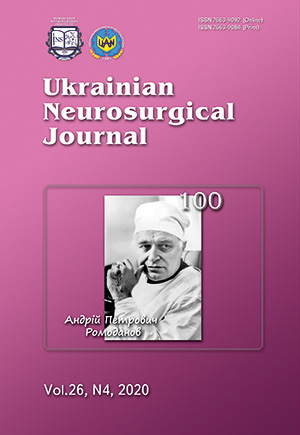Clinical observation of surgical treatment of cavernous malformation of the dorsal pons using intraoperative neurophysiological monitoring
DOI:
https://doi.org/10.25305/unj.209171Keywords:
brainstem, cavernous malformation, intraoperative neurophysiological monitoring, somatosensory evoked potentials, acoustic brainstem evoked potentials, cranial nervesAbstract
The presented clinical observation of surgical treatment of cavernous malformation of the left dorsal part of pons using the intraoperative neurophysiological monitoring (IONM) is of scientific and applied interest. IONM is a relatively new diagnostic and at the same time the least studied direction in the system of neurophysiological support in high-tech neurosurgical care in Ukraine. The clinical manifestations, the results of clinical and instrumental methods of examination, and the course of the operation are analyzed in detail. The ISIS IONM system (Inomed, Germany) was used for monitoring. This case demonstrates that the use of multimodal IONM allows you to identify in real time most of the structures of the central nervous system that are at risk of surgery and prevent their damage. This makes it possible to prevent the development of postoperative neurological deficits and reduce the risk of disability in patients. The factor that ensures the success of IONM is the constructive interaction of neurosurgeons, neurophysiologists, and anesthesiologist.
References
1. Giacobbo Scavo C, Roperto R, Cacciotti G, Mastronardi L. Cystic Progression of a Cavernous Malformation at the Level of the Trigeminal Root Entry Zone Presenting With Sudden Onset of Trigeminal Neuralgia. J Craniofac Surg. 2018 Nov;29(8):e728-e730. [CrossRef] [PubMed]
2. Taslimi S, Modabbernia A, Amin-Hanjani S, Barker FG 2nd, Macdonald RL. Natural history of cavernous malformation: Systematic review and meta-analysis of 25 studies. Neurology. 2016 May 24;86(21):1984-91. [CrossRef] [PubMed] [PubMed Central]
3. Xie MG, Li D, Guo FZ, Zhang LW, Zhang JT, Wu Z, Meng GL, Xiao XR. Brainstem Cavernous Malformations: Surgical Indications Based on Natural History and Surgical Outcomes. World Neurosurg. 2018 Feb;110:55-63. [CrossRef] [PubMed]
4. Gross BA, Du R. Hemorrhage from cerebral cavernous malformations: a systematic pooled analysis. J Neurosurg. 2017 Apr;126(4):1079-1087. [CrossRef] [PubMed]
5. Rajagopal N, Kawase T, Mohammad AA, Seng LB, Yamada Y, Kato Y. Timing of Surgery and Surgical Strategies in Symptomatic Brainstem Cavernomas: Review of the Literature. Asian J Neurosurg. 2019 Jan-Mar;14(1):15-27. [CrossRef] [PubMed] [PubMed Central]
6. de Aguiar PH, Zicarelli CA, Isolan G, Antunes A, Aires R, Georgeto SM, Tahara A, Haddad F. Brainstem cavernomas: a surgical challenge. Einstein (Sao Paulo). 2012 Jan-Mar;10(1):67-73. [PubMed]
7. Arauz A, Patiño-Rodriguez HM, Chavarria-Medina M, Becerril M, Longo GM, Nathal E. Rebleeding and Outcome in Patients with Symptomatic Brain Stem Cavernomas. Cerebrovasc Dis. 2017;43(5-6):283-289. [CrossRef] [PubMed]
8. Farhoud A, Aboul-Enein H. Surgical management of symptomatic brain stem cavernoma in a developing country: technical difficulties and outcome. Neurosurg Rev. 2016 Jul;39(3):467-73. [CrossRef] [PubMed]
9. Ren Y, Li J, Tao C, Zheng J, Zhang S, Xiao A, Chen R, You C. Surgical Treatment of Cavernous Malformations Involving the Midbrain: A Single-Center Case Series of 34 Patients. World Neurosurg. 2017 Nov;107:753-763. [CrossRef] [PubMed]
10. Georgieva VB, Krastev ED. Surgical Treatment of Brainstem Cavernous Malformation with Concomitant Developmental Venous Anomaly. Asian J Neurosurg. 2019 Apr-Jun;14(2):557-560. [CrossRef] [PubMed] [PubMed Central]
11. Cannizzaro D, Sabatino G, Mancarella C, et al. Management and Surgical Approaches of Brainstem Cavernous Malformations: Our Experience and Literature Review. Asian J Neurosurg. 2019;14(1):131–139. [CrossRef]
12. Georgieva VB, Krastev ED. Surgical Treatment of Brainstem Cavernous Malformation with Concomitant Developmental Venous Anomaly. Asian J Neurosurg. 2019;14(2):557–560. [CrossRef]
13. Gaytan AS, Krivoshapkin AL, Karaskov AM, Kanygin VV, Valentik AV. [Results of surgical treatment of patients with glioblastomas using a combined 5-ala fluorescent-guided resection]. Patologiya krovoobrashcheniya i kardiokhirurgiya. 2014;18(2):37-41. Russian. [CrossRef]
Downloads
Published
How to Cite
Issue
Section
License
Copyright (c) 2020 Vladimir V. Moroz, Oksana Y. Skobska, Noureddin Shakhin, Aleksandra Y. Malysheva

This work is licensed under a Creative Commons Attribution 4.0 International License.
Ukrainian Neurosurgical Journal abides by the CREATIVE COMMONS copyright rights and permissions for open access journals.
Authors, who are published in this Journal, agree to the following conditions:
1. The authors reserve the right to authorship of the work and pass the first publication right of this work to the Journal under the terms of Creative Commons Attribution License, which allows others to freely distribute the published research with the obligatory reference to the authors of the original work and the first publication of the work in this Journal.
2. The authors have the right to conclude separate supplement agreements that relate to non-exclusive work distribution in the form of which it has been published by the Journal (for example, to upload the work to the online storage of the Journal or publish it as part of a monograph), provided that the reference to the first publication of the work in this Journal is included.









